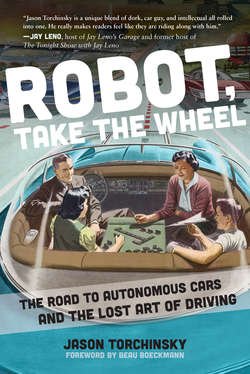Robot, Take the Wheel

Реклама. ООО «ЛитРес», ИНН: 7719571260.
Оглавление
Jason Torchinsky. Robot, Take the Wheel
Beau Boeckmann, President and Chief Operating Officer of Galpin Motors
We’ve Been Here Before
How Did We Get Here?
1478: da Vinci’s Cart
1830s–1840s: Railroads
1866: Whitehead Torpedo
1925: Houdina American Wonder
1933: Mechanical Mike Autopilot
World War II: Project Pigeon
1940: Automatic Transmission
1945: Cruise Control
1956: GM Firebird II Concept Car
1957: RCA Labs and the State of Nebraska’s Experimental Highway
1960: UK Transport and Road Research Laboratory’s Experimental Four Miles of M4
1961 to 1979: The Stanford Cart
1977: Tsukuba Mechanical Engineering Lab, Japan
1980s: Ernst Dickmanns: The Man Who Made Cars See
2004: The DARPA Grand Challenge
How Do They Work, Anyway?
Ultrasonic Sensors
Cameras
Radar
Lidar
GPS
Communication and Combining Everything
Self-Driving Cars Don’t Really Get to Be Dirty
Semiautonomy is Stupid
They’re Robots, Not Cars
Ethics, Behavior, and Being Better than People Are
They Shouldn’t Look like Cars
The Death of the Journey
Will They Be Like Your Dog?
1. Car Herding!
2. Instant Unwanted Autocross!
3. Auto Sumo!
4. The Trap!
Save the Gearheads
Отрывок из книги
Take the Wheel
Take the Wheel
.....
For what it did, Mechanical Mike was surprisingly small, being only about 9 inches by 10 inches by 15 inches.8 The box housed two air-driven, 15,000 rpm (revolutions per minute) gyroscopes, one for azimuth/direction and one for lateral control of the airplane. Air-actuated servo valves connected to the gyroscopes hydraulically controlled the aileron, elevator, and rudder of the plane, giving full three-axis control of the aircraft.
Mechanical Mike required no electrical power, being entirely pneumatic, and only weighed seventy pounds. These were significant advantages over other autopilot systems, and Mike proved to be remarkably reliable. Mechanical Mike and other early gyro-based autopilot systems are significant in the development of autonomous vehicles because they represent the very first time a fully mechanical vehicular control system was trusted enough to transport passengers. The wide use of the Mechanical Mike following Post’s trip marked the first mass deployment of a situationally/environmentally reactive autonomous vehicle system, and, with nearly every major aircraft today employing a much more advanced version, represents the most common autonomous vehicle fleet currently in use on Earth.
.....